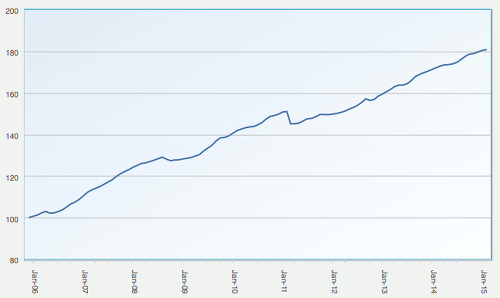The average ILS fund return across a group of 34 insurance-linked securities (ILS), reinsurance linked investment and catastrophe bond funds was only 0.11% in April, as weak cat bond market performance and private ILS loss reserving from Australian catastrophe events hit.
The 0.11% average return for the month of April, for the group of ILS funds tracked by the Eurekahedge ILS Advisers Index, is the second lowest April return on record. Only April 2011 saw worse performance, when the ILS market was recovering from the impact of the Japanese earthquake and the Index only returned 0.06%.
Stefan Kräuchi, founder of ILS Advisers, commented; “The April return of Eurekahedge ILS Advisers Index is 0.11%, the lowest April return except 0.06% in 2011. The index grew 0.95% in the first 4 months of 2015, also the second lowest YTD return following 2011.”
Recent severe weather events in Australia have had a noticeable impact on the ILS Advisers Index in April (as Artemis suggested a fortnight ago), with as many as five of the ILS funds that invest in private ILS and collateralized reinsurance reporting negative returns for the month.
Artemis understand that at least two of these ILS funds are negative due to the events in Australia, but it should be noted that it’s not possible to confirm whether that is the cause of the other three’s poor month. However, Australia does seem the most likely cause of all five being down, with U.S. convective storm and tornado losses the other possible reason (or a combination of the two).
These catastrophe events, including the east coast low that struck New South Wales and severe hail storm that struck Sydney, are estimated to have caused insurance industry losses of AUD$1.55 billion or greater.
The fact that ILS funds have reserved for potential losses from the events in Australia, causing an impact to their April net asset values NAV’s, shows that ILS managers are participating in reinsurance programs at much lower industry loss levels in Australia than they do in larger catastrophe reinsurance markets such as the U.S. and Europe.
These losses are small however, Kräuchi explained; “The frequency of events in Australia had eroded layers of some aggregate contracts and slightly affected the NAVs of some ILS funds. However, overall the impact to the asset class was very small.”
The catastrophe bond market continues to erode ILS fund performance, particularly for the pure cat bond funds, as price returns have struggled through much of 2015. This continued through April causing a number of the pure cat bond funds to report negative returns once again.
With U.S. hurricane season now upon us there is an expectation that price declines will slow and there could be some recovery in the cat bond market.
“Secondary trading was active and there may be a price rebound as the hurricane season starts,” stated Kräuchi.
Four pure catastrophe bond funds reported negative returns for April, alongside the five private ILS fund strategies. It’s unusual for the private ILS funds to suffer more than the cat bond funds, in recent years, however as a group the higher return potential of collateralized reinsurance continues to help the private ILS group outperform.
“The private ILS funds keep outperforming the pure cat bond funds by 2.99% on annualized basis and we expect the trend to continue.
“The difference between the best and the worst performing fund was 1.30 percentage points, which was higher than previous month’s figure. Pure cat bond funds as a group were up by 0.01% while the subgroup of funds whose strategies include private ILS increased by 0.17%,” Kräuchi said.
Finally, ILS Advisers notes a trend that sees certain ILS managers now beginning to offer multi-class collateralized reinsurance covers, as a way to boost returns.
“Due to the soft reinsurance market, we observe some managers packaging different lines of business into one collateralized contract to enhance returns, so called “risk bundling”. This strategy increases the return on collaterals but at the same time increases the uncertainty of underlying risks. Risk bundling requires ILS managers to have more underwriting skills, modelling capacity and reinsurance expertise,” Kräuchi explained.
Apparently this is largely on aggregate reinsurance contracts and some ILS managers now have a significant number of such positions within their portfolios, while others have none.
It is typical for uncorrelated risks, which share the same limits, to be included in contracts in this way, according to ILS Advisers. This might include bundling property catastrophe risks with classes such as marine.
You can track the Eurekahedge ILS Advisers Index on Artemis here including the new USD hedged version of the index. It comprises an equally weighted index of 34 constituent ILS funds which tracks their performance and is the first benchmark that allows a comparison between different insurance-linked securities fund managers in the ILS, reinsurance-linked and catastrophe bond investment space.
 View all of our Artemis Live video interviews and subscribe to our podcast.
View all of our Artemis Live video interviews and subscribe to our podcast.
All of our Artemis Live insurance-linked securities (ILS), catastrophe bonds and reinsurance video content and video interviews can be accessed online.
Our Artemis Live podcast can be subscribed to using the typical podcast services providers, including Apple, Google, Spotify and more.
































